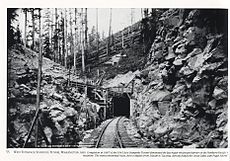This Week in Cascadia: May 27th – June 3rd
This Week in Cascadia is a weekly segment. You can view all Weeks in Cascadia history from its main page here.
Submit a historical news item from Cascadia’s past! The button below leads to a reader submission form.
This Week in Cascadia: May 27th – June 3rd
May 27, 1888 – The Stampede Pass railroad tunnel, located in the Cascade Mountains
about 40 miles east of Tacoma, and roughly 15 miles northeast of Cle Elum, is
completed. The 1.8 mile long tunnel, which crosses from King County into Kittitas

County, opens a new railroad gateway from Puget Sound to the East. Before the
Stampede Pass tunnel, the process of scaling the Cascades by train was an ordeal
involving a series of switchbacks. The completed tunnel allowed for relatively easy
passage. The tunnel, initially serving the Northern Pacific Railroad, made Seattle and
Tacoma primary contenders for economic dominance of the Pacific Northwest. The late 20th century saw the tunnel closed for over decade. Other routes were used until in 1997 the tunnel with reopened after extensive rebuilding.

For further reading on the adventurous expeditions to find, plan and build this tunnel route, critical to the development of transcontinental rail, click here.
May 28, 1948 – Seattle College president Fr. Albert A. Lemieux, SJ announces the
school’s re-incorporation as Seattle University.
Seattle University Professor Emeritus David McCloskey, “Father of Cascadia” speaks.
The Jesuit-run Seattle College was chartered in 1898, and grew out of the School of the Immaculate Conception, founded in 1891. As of 2001, Seattle University is the largest independent university in the Pacific Northwest, with an enrollment of 6,000, and is the region’s leading Jesuit institution.
May 29, 1993 – University Heights Farmer’s Market opens in the University District at
the University Heights Community Center in Seattle, Washington. Located at the corner
of NE 50th and University Way NE, the University District Farmers Market springs to
life every Saturday from May to November, with more than 40 venders, all local farmers,
selling bread, flowers, red beets, broccoli, lettuce, peas, corn, onions, cabbage, green
beans, fresh berries, and other fruits and vegetables. It also allows residents a chance to
meet farmers from rural areas. Visit their web page here.
May 30, 1792 – British explorer Captain George Vancouver sailing on the Discovery, drops anchor at Elliott Point, the site of present-day Mukilteo, Washington. The following morning crewmembers from the Discovery disembark for exploration.
An account and in depth documentary about the Captain, his ship and voyage below.
May 31, 1936 – Attorney Thomas Masuda drafts a constitution for the Pacific Northwest
Japanese Golf Association in Seattle, where the sixth Annual Tournament is being held.
Masuda becomes the association’s first president. The association would continue to hold
annual tournaments in Northwest cities until 1941, when all persons of Japanese descent
are forced by the American and Canadian governments to leave the West Coast.

June 1, 1905 – Opening Day for the Lewis and Clark Exposition, the first world’s fair to be held on the west coast and Portland’s first and only world’s fair. A grand parade
kicked things off at 10am at SW 6th and Montgomery, where mounted police led
marching bands, 2,000 Oregon National Guardsmen, and more police to bring up the
rear. The Lewis and Clark Exposition marked the centennial of the Lewis and Clark
expedition and thrust Portland into the international limelight. The 400-acre fairgrounds
in NW Portland drew in excess of 1.5 million visitors during the fair’s four and a half
month run. Portland’s population at the time was only about 120,000.
June 1st this year, attend Cascadia Magazines inaugural event! Details at this link.
Rand Raynor leads a brief history of the exposition.
June 2, 2012 – The first annual Seattle Science Festival starts with Science Expo Day on the grounds of Seattle Center. The month-long festival features more than 150 exhibits, displays, demonstrations, and programs on science, technology, and innovation and is part of the 50th anniversary celebration of the Seattle World’s Fair and the Pacific Science Center.
Opening day draws more than 20,000 children and parents to the center, and science-related events will continue into July. The festival, considered by many to be long overdue in a city famous for its computer, aerospace, and other high-tech industries,
is sponsored by many of the Northwest’s leading research institutions, museums, schools and universities, businesses, and non-profits.
June 3, 1889 – At 6:30 a.m., fire breaks out in the middle of the business district in
downtown Republic, located in Ferry County in North Central Washington. The fire
quickly spreads throughout this just-established gold-mining boomtown. Desperate
firefighters use dynamite to stop the spread, in vain. Finally after several more building
are dynamited, the flames are checked. When it was all over, more than half of Republic’s
downtown business district was destroyed, with damages estimated at $100,000 and most
of the losses are not insured. However, the town was in the midst of its gold boom and
rebuilt immediately.
Don’t forget to submit your own Cascadian history events at the link below.


